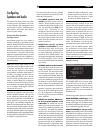
27
English
NOTE
: If the TUNER is not already the selected
input, pressing a NUMERIC button on the front-
panel activates the TUNER. If using the NU-
MERIC buttons on the remote, first manually
select the tuner input, if not already active.
The NUMERIC buttons can also be used for
direct access tuning (see next section).
DIRECT Button
FRQ DIRECT Button
If you know the frequency of the desired sta-
tion, you may tune it directly using the DIRECT
button and the NUMERIC buttons.
1. Press the DIRECT button on the front panel
or the FRQ DIRECT button on the remote
to change the NUMERIC buttons from sta-
tion preset to Direct Access mode. The sta-
tion frequency in the front-panel display will
change to a series of four bars, represent-
ing the digits of a station frequency, with
the first bar flashing.
2. Enter the first digit of the station frequency
using the NUMERIC buttons. The digit will
appear in the frequency display and the
second bar will flash. Enter the remaining
digits of the frequency. When all of the
necessary digits have been entered, the
receiver will tune to the displayed station
frequency. Note that entering a station fre-
quency is slightly different for the USA and
Europe:
In the USA:
FM87.50MHz Press: 8>7>5
FM101.90MHz Press: 1>1>9
AM1410kHz Press: 1>4>1
In Europe:
FM87.50MHz Press: 8>7>5>0
FM101.90MHz Press: 1>1>9>0
AM1413kHz Press: 1>4>1>3
MONO Button
FM MONO Button
The MONO button on the front panel or the
FM MONO button on the remote change the
FM mode from stereo reception to mono re-
ception. In stereo mode, a stereo signal will
be heard if the station is broadcasting a ste-
reo signal and there is sufficient signal strength.
An ST indicator will light in the front-panel
display. In mono mode, a mono signal will be
heard even if the station is broadcasting a stereo
signal.
NOTE
: Switching to mono mode can improve
the reception of weak or distant FM signals.
Less signal strength is required for clean mono
reception than for stereo reception.
TUNE Button
PRESET Button
P-TUN Button
These remote control buttons are used to change
between FREQUENCY tuning mode and PRE-
SET tuning mode. In frequency tuning mode,
the TUNING buttons (CH UP/DOWN on the
remote ) advance to the next station frequency.
In preset tuning mode, the TUNING buttons
advance to the next memorized station pre-
set.
Select the FREQUENCY tuning mode by press-
ing the TUNE button on the remote. Select the
PRESET tuning mode by pressing the PRESET
button on the remote. Toggle between the two
modes by pressing the P-TUN button. A PRE-
SET indicator appears in the display when PRE-
SET TUNING is activated.
SCAN Button
This button activates a preset scanning feature.
When you press the button, the tuner begins
scanning through all memorized station pre-
sets, playing each for 5 seconds before mov-
ing to the next. To stop the station scanning
when the desired station preset is reached,
press the button again.
NOTE
: If a PRESET station is currently tuned
when the PRESET SCAN button is pressed,
scanning will start with the next higher preset
number and continue through all presets, stop-
ping on the initial preset. If a PRESET station
is not currently tuned when the button is
pressed, scanning will start from PRESET 1
and continue to PRESET 30.
RDS and RBDS Tuning
The Rotel RSX-1067 is equipped with RDS (Ra-
dio Data Systems) reception capabilities for
Europe and RBDS (Radio Broadcast Data
Service) capabilities for the United States. These
broadcast systems provide additional function-
ality to FM radio reception by transmitting en-
coded information along with the radio sig-
nal. This signal is decoded by an RDS or RBDS
receiver and can provide a range of informa-
tional features including:
1. a display of the station’s identifying name
(e.g. BBC1)
2. a display of the station’s program content
(e.g. ROCK or NEWS)
3. traffic information broadcasts
4. a scrolling text display for announcements
or information
In addition, RDS provides several advanced
search features including:
1. Search for a station with the desired pro-
gram content (PTY)
2. Search for traffic information (TP)
3. Search for stations broadcasting special
traffic announcements (TA).
RDS broadcasting has been widely available
in many European markets for years. There
are a large number of RDS stations and most
users will be familiar with the features and
operation. In the USA, implementation of the
RBDS system is more recent. Fewer stations
are broadcasting RBDS signals and the fea-
tures may be less familiar to many users. Consult
your authorized Rotel dealer for more infor-
mation on RDS or RBDS broadcasting in your
area.
NOTE
: The RDS and RBDS features are en-
tirely dependent on the broadcaster sending
encoded signals. Thus, they will only be avail-
able in markets where RDS or RBDS is imple-
mented and where stations are broadcasting
these data signals. If there are no RDS or
RBDS stations, the RSX-1067 will function as
a standard radio receiver.
NOTE
: RDS and RBDS services are only avail-
able on FM broadcasts. The features and but-
tons described below are only operational in
FM mode.


















